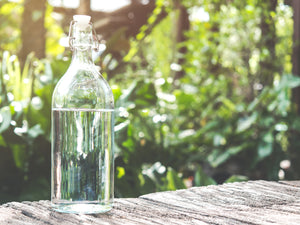You can find examples of water, air, and surface UV applications as early as the 1900s. But UV really started to take off as a disinfection technology in the 1970s. By the time the 1990s and 2000s rolled around, UV experienced a massive growth in water and wastewater applications.
It is a fairly simple concept. UVC photons penetrate the cell wall, disrupt the DNA, then leave the virus or bacteria inactive (aka “killed”), unable to replicate. The technology first started being used for drinking water in Germany and Austria, and wastewater in the U.S. This reduced the need for chemicals in the water with risky by products, inactivated even chemical-resistant pathogens, and was easy to use.
Chances are UV technology is already being used as a safe and reliable way to treat your drinking water if you live in Canada. You can apply this technology to kill germs in the air or on surfaces in your home or business at multiple affordable price points.
One way to reduce the spread of airborne pathogens is to invest in a UV air purifier. At UV CAN Sanitize, our top-selling Tulip 2 and Cosmos Wall Mount air purifiers are not only equipped with a HEPA filter and activated carbon filter, but also germicidal UVC lights that inactivate viruses and bacteria, reducing their concentration in the air indoors.
Tulip 2 UV Air Purifier |
Cosmos Wall Mount UV Air Purifier |
 |
 |
|
Tulip 2 is the best portable air purifier for your home or your desk in the office as it disinfects and purifiers the air at a rate of 2,472 to 3,885 ft³ per hour. |
Cosmos Wall Mount disinfects at a rate of 35,300 ft³ per hour making it perfect for your large office space, boardroom, waiting room, or reception area. |
Keep reading to learn about a few examples where UV is being used to disinfect water in Canada:
Coquitlam Water Treatment Plant, Coquitlam, British Columbia
This facility has been treating Coquitlam source water with UV since 2014. It delivers roughly one third of the total potable water supply to the Metro Vancouver region at 370 million litres per day. The UV light inactivates harmful micro-organisms and does not alter the taste, colour, or odour of water. The water at this plant is treated with ozonation, then UV, and lastly with chlorine.
Seymour Capilano Filtration Plant, North Vancouver, British Columbia
This is Canada’s largest drinking water filtration plant with the capacity to treat up to 1.8 billion litres per day for Vancouver and the surrounding cities. It first started operating in 2009. Its two main processes for treating drinking water are filtration and UV. Filtration reduces the need for chlorine since it removes particulates, organic matter, and micro-organisms. The UV light inactivates any viruses or bacteria from the source water.
Deacon Reservoir, Winnipeg, Manitoba
UV disinfection has been used to treat water in Winnipeg and protect from parasites since May 2006. This facility’s UV lights are intense enough that the water only needs a few seconds of exposure to inactivate bacteria and viruses. UV light is beneficial in this facility since it doesn’t require handling, storing, or monitoring dangerous chemicals and there is no risk of overdosing or overtreating the water.
Lethbridge Water Treatment Plant, Lethbridge, Alberta
Construction for Lethbridge’s water treatment plant equipped with UV disinfection finished in December 2003. This plant has the capacity for 150 million litres per day and supplies 77,000 residents, as well as agricultural, institutional, industrial, and commercial sectors. It was an answer to the community’s growing concerns about drinking water quality and chemical-resistant microbes.
Sherbourne Common Stormwater Treatment Facility, Toronto, Ontario
This treatment facility was finished in 2011 alongside a waterfront park in Toronto. When it rains heavily, combined sewer overflow (CSO) contaminates the water supplied to the park. UV is used to treat the runoff water so it is still suitable for human contact in Lake Ontario. The UV treatment process is actually more effective against chlorine-resistant protozoa such as Giardia and Cryptosporidium.
UV is being used as a chemical-free and environmentally friendly way to inactivate viruses and bacteria in your very drinking water all across Canada. If you are looking to incorporate this technology as an extra preventative measure against dangerous pathogens, check out our UV air purifiers, Tulip 2 and Cosmos Wall Mount for your home or workplace respectively.

